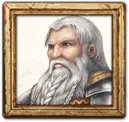
Executioner’s Sword
“I’ve never seen a larger and more terrifying sword.”
— Olgarta Firunjev, runaway serf from Bornland, 1039 FB
The executioner’s sword is not so much a weapon as a symbol of class oppression. These two-handed swords hold an extremely fine edge but are not suitable for combat because they usually don’t have cross-guards and are often unbalanced. They excel only at decapitating those who are sentenced to death.
When not in use, most executioner’s swords remain locked away in city armories or in fortresses. As symbols of the local ruler or jurisdiction, these weapons usually bear numerous engravings that are pleasing unto Praios and Boron. Many people believe that these engravings prevent the souls of executed victims from entering the blades, or ward curses uttered by victims. Some executioner’s swords are sanctified.

“Sure, the sword has a sharp edge and can cause grievous injuries, but it is simply too unwieldy. Choose another weapon for battle.”
— Arbosh son of Angrax, forge dwarf master smith
